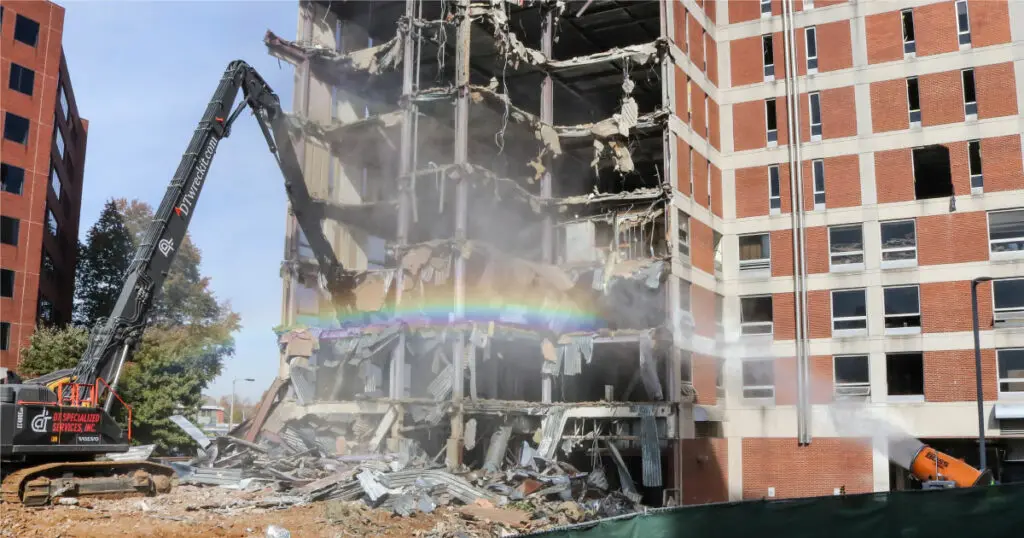One of the global leaders in open area dust suppression has announced the introduction of a new component in its arsenal of custom solutions: a family of tower mounts for the company’s atomized misting equipment, which extends droplet hang time and range, while providing more precise aiming capability. Complementing a product line that already includes wheeled carriages and skid mounts, by delivering millions of 50-200 micron droplets per minute from above dust-generating activities, tower-mounted dust control units help commercial operations achieve superior particle control and prevent dust from migrating off-site.
BossTek developed the new tower designs specifically to address ongoing operations that generate dust in fixed locations. They are well suited for slag handling, aggregate processing, recycling operations and coal handling.
“The tower mounts can deliver a focused mist to the areas where dust is created,” commented BossTek General Manager Laura Stiverson. “This allows the DustBoss units to concentrate virtually their entire output directly to the source of the problem.” Designed to withstand wind loads of at least 100 MPH, the towers are constructed of carbon steel pipe, hot dip galvanized to resist corrosion.
To further customize a dust solution for individual customer sites and conditions, any of the fan-driven units can be modified to address specific particle sizes or service environments. “In some applications such as slag handling, the dust particles can be so small that they are more effectively managed with smaller droplets,” Stiverson observed. “In other situations, reduced flow may be preferred to protect moisture-sensitive materials.”



In either case, the company can apply its Variable Particle Sizing (VPS) technology to match the dust to the most appropriate droplet size and water delivery. “The most effective suppression takes place when the dust particles and droplets are roughly the same size,” she reminded.
Three tower sizes are currently available. The 6" base tube is generally employed on tower heights under 15 feet, and is compatible with the standard oscillation package. For greater elevation, 8" diameter towers are used.
The heavy-duty design is the 10" diameter flange-mounted towers, which are secured directly into concrete. Available in heights up to 20 feet, the large diameter allows hoses and power cords to be routed inside the tower for protection and a “cleaner” appearance. The flange-mounted units feature programmable oscillation, with a customer-settable range from 0-359º. Climbing rungs, work platforms, booster pumps and additive metering systems are all available as options.
Once installed, users have two options for raising and lowering the tower. The manual jack has a long handle attached, allowing operators to rotate the handle to change the height from the ground. When fitted with the optional electric jack, changes can be made via the control panel or remote control unit. With motion limits set by the program, the operator simply activates the jack until it reaches the desired position, allowing quick and easy adjustments to accommodate weather changes or specific work activities.

The ability to network multiple machines and/or automate the on-off cycles can be a big advantage to large operations. “Automated units can be operated from a single radio-controlled, hand-held remote to conserve resources and avoid over-saturation, with the units running only during dust-generating activity,” Stiverson explained. The radio-powered remote control allows rapid start-up or adjustment of the machines by a single operator, without any manual contact.
In fully-automated systems, the network can be equipped with sensors that track wind and weather details, with customized software and programmable logic control via computer. Driven by proprietary software, the resulting “intelligent” systems can be programmed to manage start/stop cycles based on dust monitor readings, motion sensors or weather input. The technology allows users of DustBoss equipment to automatically adjust elevation, oscillation range and other features on any number of machines to improve suppression efficiency and free up manpower for other tasks.
The tower units provide a versatile, customizable dust and odor control solution. Spraying the worksite from above, the tower units help prevent nuisance dust or odor from entering the air stream, greatly reducing the possibility of fugitive dust leaving the worksite. With the number of tower sizes and available options, the systems are customized based on the needs of the specific application and individual location.
BossTek is a global leader in dust and odor control solutions for mining, rock and aggregate processing, demolition, recycling and scrap processing. The company’s DustBoss product line helps reduce labor costs vs. manual sprays, freeing up manpower for more important tasks. The automated units also use less water than hoses and sprinklers, with some customers realizing payback in less than six months and netting an annual cost savings of more than $50,000. bosstek.com
Elevate your dust control with DustBoss Towers Today!
Receive a FREE quote and talk to a dust control specialist to determine the ideal locations for DustBoss Towers tailored to your site!
Get A Quote
More on BossTek
Subscribe and Stay Up-to-Date!
Receive a monthly newsletter keeping you up-to-date on the latest in dust and odor control.
Subscribe





